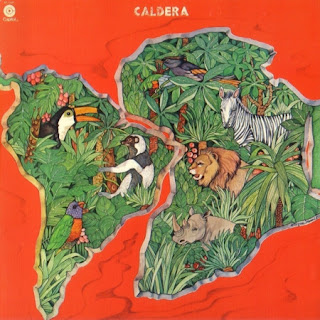The group hailed from different parts of Latin America, as well as the US. I'll cover the changes to personnel as we go, as usual. Often times heavy on guitar and keys, we also have great sax play along with plenty of percussion. A favorite of mine. An obvious Latin-influence, but not what I would describe as Latin-jazz, by any means.
First up for today we have the self-titled, Caldera from 1976. From the group's onset, we have Argentinian pianist, Eduardo del Barro, US-born saxophonist, Steve Tavaglione, Costa Rican guitarist, Jorge Strunz, US-born bassist, Dean Cortez, and Cuban drummer, Carlos Vega. We also have Brazilian trombonist, Raul de Souza, Brazilian percussionist, Roberto da Silva, and an additional percussionist in Mike Azevedo.
This album jumps right out of the gate, for me. I instantly fell in love with this group. It's probably unnecessary for me to highlight my favorites here or we'll never finish up. One note is that on "Coastin'" and "Exaltation" (both excellent) we have some non-lyrical vocals from Carolyn Davis. I was able to pull them out on "Coastin'" but unable to on "Exaltation." I find them somewhat annoying but del Barrio on synthesizer more than makes up for it. Not a skippable track to be found on this one. Classic material.
Next up, we have my introduction to the group, in 1977's Sky Islands. The only album I was able to find on streaming. The same group returns and joining them are a sleuth of guest appearances that I won't list here to save time and space. My favorites here are "Pegasus" and "Carnavalito," but I also dig this one from start to finish. "Ancient Source" has some vocals and I've included an instrumental, as well. The intro to "Triste" is about as good as it gets, in my opinion. If it hasn't been sampled heavily, I'd be surprised.
The following year in 1978, the group released it's third album, Time And Chance. The group welcomes American bassist, Gregg Lee, who we may remember from the latter Native Son albums we covered previously. We also have drummer, Alex Acuña, and percussionist, Hector Andrade.
One thing to note here is the I-Ching hexagram on the album cover. I have novice level knowledge of the book of changes but it's a useful tool for anyone focused on improving their present and seeking guidance for the future. The hexagram here is for "cauldron" suggesting cooking in a literal and spiritual sense. Aside from the obvious: Caldera translating to Cauldron in English, this band was certainly cooking.
This album is a touch softer, in my opinion, and features more acoustic guitar than we've previously heard. "Shanti" is a very nice track that does feature some vocals - and I've again included an instrumental.
The final installment for us is 1979's Dreamer. The same group from Time And Chance returns with the addition of well-traveled percussionist, Luis Conte. Again, we have quite a few guests that I won't include here. This is the album I return to the least but there are still some gems to be heard. The soprano sax from Tavaglione on "Dreamchild" is constantly stuck in my head. Other nice tunes here are "Rain Forest" and the closing "Himalaya."
The only real disappointment I have with the group is that their run only lasted these 4 albums. I haven't dug into the other projects the members pursued, aside from a quick look into Hiroshima, which original bassist Dean Cortez, was a part of.
Check back throughout the week - I have a few other posts on deck that are some of my favorites.
Also, please let me know if anyone is having issues with the links. Krakenfiles is being a bit cantankerous so I'm considering shifting to something different.




https://krakenfiles.com/view/psrrEGZgc8/file.html
ReplyDelete